What is Skin Boosters Market Size?
The global skin boosters market size accounted for USD 1.59 billion in 2025 and is predicted to increase from USD 1.80 billion in 2026 to approximately USD 4.81 billion by 2034, expanding at a CAGR of 13.05% from 2025 to 2034. The skin boosters' market is experiencing a major glow-up quite literally. As more people seek subtle, natural-looking ways to improve their skin, injectable skin boosters have quickly become a go-to treatment. These products help hydrate the skin from within, smooth out fine lines, and restore a healthy, radiant look without the need for surgery. From busy professionals to skincare enthusiasts, the demand is growing for treatments that fit into everyday life but deliver noticeable results.
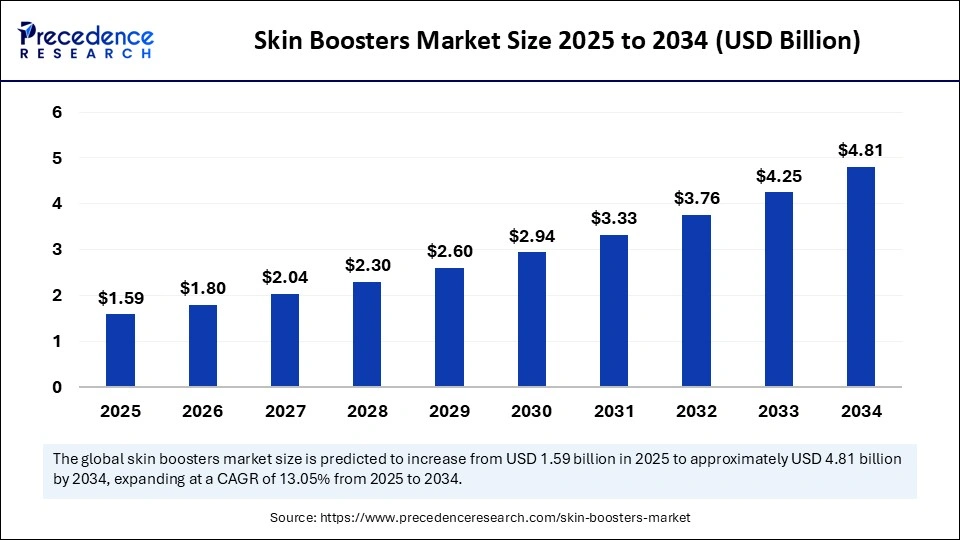
Market Highlights
- By region, North America dominated the market, holding largest market share by 45% in the year 2024.
- By region, Asia Pacific is expected to expand at the fastest CAGR in the market by 12% between 2025 and 2034.
- By product type, the Hyaluronic Acid (HA) Skin Boosters segment held the largest of market share in 2024.
- By product type, PRP & Autologous Biologics is expected to grow at a remarkable CAGR of between 2025 and 2034.
- By technology node type, the cross-linked HA optimized for intradermal use segment held the largest of market share in 2024.
- By technology node type, autologous biologic concentrates are expected to grow at a CAGR of between 2025 and 2034.
- By application type, the facial skin rejuvenation segments held the largest market share 55% of in 2024.
- By application type, mobile SoCs is expected to grow at a remarkable share of 14% CAGR between 2025 and 2034,
- By delivery/procedure type, the microdroplet Intradermal injections segment held the largest market share of in 2024.
- By delivery/procedure type, topical infiltration is expected to grow at a remarkable CAGR between 2025 and 2034,
- By end-user type, the dermatology & plastic surgery Clinics segment held the largest market share of in 2024.
- By end-user type, medspas & cosmetic chains is expected to grow at a remarkable CAGR between 2025 and 2034,
- By business model type, the Procedure fees & clinic services segment held the largest market share of in 2024.
- By business model type, bundled combo-protocols is expected to grow at a remarkable CAGR between 2025 and 2034
From Niche to Necessity: Mapping the Global Boom in Skin Boosters
Today's beauty market is no longer just about makeup and creams; it is about what is going on beneath the surface. The global skin boosters' market is riding this wave, with strong growth across North America, Europe, and Asia-Pacific, where non-invasive aesthetic treatments are now part of mainstream skincare routines. Whether it is a quick lunchtime procedure or a preventative step in a long-term skincare plan, skin boosters are gaining popularity across age groups and genders.
Major brands and clinics are expanding their offerings, while consumers are increasingly willing to invest in treatments that make them look and feel their best. There's also a noticeable uptick in demand from emerging markets like Latin America and the Middle East, where improving access to cosmetic treatments is opening new opportunities. With rising disposable income, growing skin health awareness, and a cultural shift toward embracing aging gracefully, this market is poised for even bigger things ahead.
How AI is Impacting the Market?
Artificial Intelligence is no longer serving as just the world but as well setting a path ahead for future; it's actively changing how we care for our skin. In the skin boosters market, AI is helping dermatologists and aesthetic professionals deliver more personalized, accurate treatments based on a person's unique skin condition. Smart skin scanners and AI-powered apps can now analyze your skin texture, hydration levels, and even signs of aging, then recommend the most suitable skin booster formulations. On the development side, AI is helping brands create smarter, more effective products by predicting how different ingredients interact with various skin types. It's also improving post-treatment monitoring, offering real-time insights and recommendations to maintain results for longer. All in all, AI is making skin boosters smarter, safer, and more tailored than ever, helping consumers get the results they want with greater confidence.
Market Key Trends
- Personalized Skincare Is Taking Over: More people are looking for skincare that fits them not just one-size-fits-all products. Personalized skin booster treatments, guided by AI tools and professional analysis, are becoming a standard part of the experience.
- Everyone Wants the “Natural Look”: There is a growing demand for treatments that enhance natural beauty rather than drastically change appearances. Skin boosters offer that subtle glow and hydration boost that feels fresh and effortless.
- Beauty Meets Wellness: People are connecting skincare to their overall well-being. Skin boosters are being seen as part of a holistic self-care routine, promoting healthy skin from the inside out.
- Tech-Driven Formulations:Next-gen boosters are incorporating innovative technologies like cross-linked hyaluronic acid, which offers longer-lasting hydration and smoother results. These smarter formulations are attracting both professionals and consumers.
- Social Media as the New Beauty Consultant: From TikTok testimonials to Instagram before-and-afters, social media is a huge driver in how consumers learn about and trust these treatments. Influencers and skin experts sharing real results are helping to normalize and demystify injectables.
Skin Boosters Market Outlook
- Industry Growth Overview: The skin boosters market is poised for substantial growth from 2025 to 2034, driven by rising demand for minimally invasive aesthetic procedures, increasing consumer awareness of skin health, and a desire for glow-enhancing and preventive treatments.
- Global Expansion: Leading companies are extending their geographic reach, especially into the Asia-Pacific region, which is expected to be the fastest-growing market due to increasing disposable incomes, medical tourism, and the vibrant beauty cultures in countries like South Korea and China. North America continues to be a dominant market, supported by advanced healthcare infrastructure and high consumer spending power.
- Major Investors: Venture capital firms, private equity, and strategic investors like AbbVie, Galderma, and Merz Pharma are actively entering the space, drawn by strong margins and the market's alignment with digital health and personalized beauty trends. These investments often involve strategic acquisitions and partnerships to expand product portfolios and technological capabilities.
- Startup Ecosystem: The startup ecosystem is evolving, with innovation centered on advanced ingredient formulations and new, less invasive delivery methods. Emerging companies are securing significant funding by providing scalable, clinically validated solutions for improved hydration and skin regeneration, often utilizing AI for personalized skin analysis and treatment visualization.
Market Scope
| Report Coverage | Details |
| Market Size in 2025 | USD 1.59 Billion |
| Market Size in 2026 | USD 1.80 Billion |
| Market Size by 2034 | USD 4.81 Billion |
| Market Growth Rate from 2025 to 2034 | CAGR of 13.05% |
| Dominating Region | North America |
| Fastest Growing Region | Asia Pacific |
| Base Year | 2024 |
| Forecast Period | 2025 to 2034 |
| Segments Covered | Product Type, Technology / Formulation, Application / Indication, Delivery / Procedure Typel, End User / Channel, Business Model / Revenue Stream, and Region |
| Regions Covered | North America, Europe, Asia-Pacific, Latin America, and Middle East & Africa |
Market Dynamics
Drivers
Fueling the Glow: Key Drivers Powering the Skin Boosters Market
The skin boosters market is primarily driven by increasing consumer demand for non-invasive, low-risk aesthetic procedures. With a growing emphasis on maintaining youthful skin, people are increasingly opting for subtle yet effective treatments such as skin boosters that enhance hydration, elasticity, and overall skin health. Additionally, the rising popularity of minimally invasive procedures, due to their quicker recovery times and less discomfort compared to traditional cosmetic surgeries, is propelling market growth.
The social media and influencer-driven beauty culture has also played a key role in normalizing cosmetic enhancements and making them more accessible to a broader audience. With growing awareness of advanced skincare options and an increasing number of clinics offering skin boosters, consumer confidence in such treatments continues to rise. Furthermore, technological advancements in formulations and the introduction of more effective, longer-lasting skin boosters are attracting more consumers to these procedures, driving the market's expansion.
Market Restraints
Balancing the Beauty: Key Challenges in the Skin Boosters Market
Despite its rapid growth, the skin boosters market faces certain challenges that could impact its trajectory. One of the primary restraints is the high cost of treatments, which can be a significant barrier for a large portion of potential consumers. Although non-invasive, skin booster treatments still require skilled professionals and expensive products, making them less affordable for many individuals, particularly in emerging markets. Additionally, concerns regarding the safety of injectables, including possible side effects and complications, continue to deter some consumers from opting for these treatments.
There is also a lack of standardization in the industry, with varying regulations and quality control measures across regions, which can create inconsistency in product performance and consumer trust. Moreover, cultural and societal factors in certain regions may limit the adoption of aesthetic treatments, especially among older populations or conservative communities. As the market grows, addressing these issues will be essential for maintaining long-term consumer confidence and expanding the market reach.
Market Opportunities
Untapped Potential: Growth Opportunities in the Skin Boosters Market
The skin boosters market presents numerous opportunities, particularly in emerging economies where there is a growing middle class and increasing demand for advanced skincare solutions. As disposable incomes rise, consumers in regions like Latin America, the Middle East, and Southeast Asia are becoming more willing to invest in non-invasive aesthetic procedures. Furthermore, the growing interest in men's grooming and skincare provides a new and expanding consumer base for skin boosters.
The continuous advancement of AI and machine learning technologies to offer highly personalized skin treatments presents another significant opportunity, allowing for more effective and targeted solutions. The rise of "beauty tech" and at-home diagnostics also opens new avenues for consumers to self-assess their skin needs before seeking professional treatments. Additionally, partnerships between skin booster manufacturers and dermatology clinics, as well as the increasing integration of skin boosters in wellness centres and spas, offer a variety of distribution channels to reach a broader audience.
Segment Insights
Product Type Insights
Why Hyaluronic Acid (HA) Skin Boosters is Dominating the Market?
Hyaluronic Acid (HA) skin boosters continue to dominate the market, accounting for an estimated 62% of the market share by 2024. The microdroplet or intradermal HA products, such as the skin booster's family, are favored for their ability to hydrate and rejuvenate the skin from within, offering long-lasting results with minimal downtime. HA is widely appreciated for its ability to retain moisture, making it ideal for improving skin texture and elasticity. These injectable treatments are used primarily for facial rejuvenation, including the perioral region, cheeks, and mid-face, which are common areas of concern for consumers. The dominance of HA in the market is largely due to its safety profile, versatility, and ability to provide noticeable improvements in skin appearance. However, as the market continues to evolve, alternative biologics are gaining traction, presenting new opportunities for innovation.
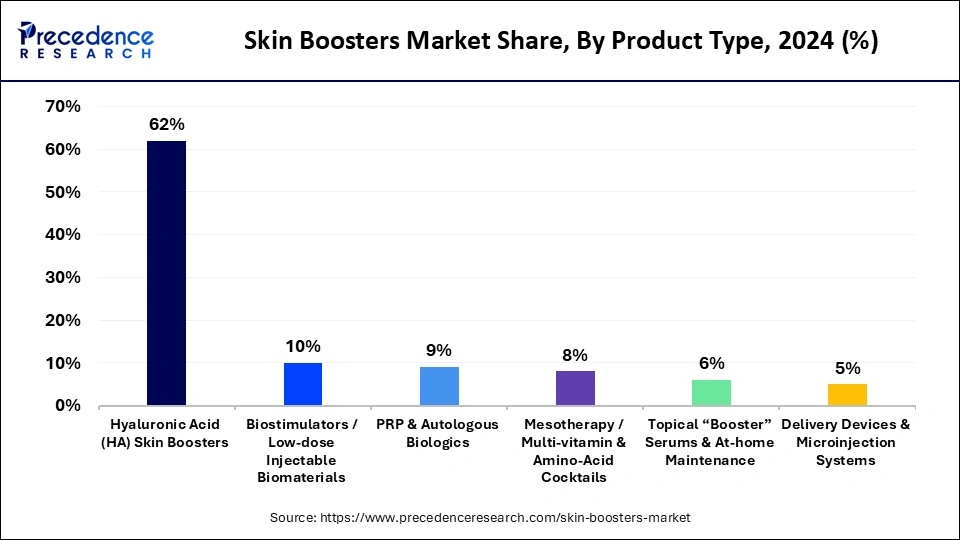
Platelet-rich plasma (PRP) and autologous biologics are emerging as the fastest-growing product segment in the skin boosters' market, with an estimated 9% market share by 2024. These treatments leverage the patient's own blood components, such as growth factors and platelets to promote natural skin regeneration and healing. PRP has gained popularity due to its ability to enhance collagen production, reduce fine lines, and improve skin tone and texture without foreign substances.
The appeal of autologous treatments is their personalized nature, reducing the risk of allergic reactions and making them suitable for patients with sensitive skin. As consumer awareness about the regenerative benefits of PRP increases, demand for these treatments is expected to rise. The growth of this segment reflects a broader trend toward holistic, naturally derived aesthetic solutions in the beauty industry.
Technology / Formulation Insights
Why Cross-linked HA Optimized for Intradermal Use is Dominating the Market?
Cross-linked hyaluronic acid (HA) optimized for intradermal use remains the dominant technology in the skin booster market. Cross-linking improves the stability and longevity of the HA, allowing it to be injected into deeper layers of the skin for more durable results. These formulations are specifically designed to provide long-lasting hydration, restoring skin volume and smoothness. HA cross-linking enhances the product's resistance to degradation, offering extended treatment effects compared to non-cross-linked HA. This technology is particularly effective for facial rejuvenation, where fine lines, wrinkles, and skin sagging are common concerns. As the market matures, advancements in cross-linked HA formulations continue to enhance their precision and efficacy, solidifying their dominant position in the industry.
Biostimulatory microparticles, such as Poly-L-lactic Acid (PLLA) and Calcium Hydroxyapatite (CaHA), in low-dose formulations are the fastest-growing technology in the market. These microparticles work by stimulating the body's natural collagen production over time, providing gradual skin rejuvenation. Unlike HA, which provides immediate results, biostimulator microparticles offer more long-term effects, addressing deeper skin concerns like volume loss and skin sagging. As consumers become more interested in treatments that offer sustainable, natural-looking results, biostimulator products are gaining popularity. This growth is further supported by the increasing demand for minimally invasive procedures that provide gradual, age-defying effects. As the technology continues to evolve, biostimulator microparticles are expected to carve out a significant market share in the years to come.
Application / Indication Insights
Why Facial Skin Rejuvenation is Dominating the Market?
Facial skin rejuvenation remains the dominant application for skin boosters, accounting for approximately 55% of the market share. The perioral region, cheeks, malar, and mid-face are common treatment areas, where skin concerns such as fine lines, wrinkles, and loss of volume are prevalent. Skin boosters are highly effective for restoring youthful fullness and improving skin texture, with results that typically last for several months. As consumers increasingly seek non-invasive treatments to maintain a fresh, youthful appearance, facial rejuvenation continues to lead the market. The growing trend of preventative treatments for skin aging, particularly among younger demographics, further supports this dominance. The safety, efficiency, and minimal downtime of facial skin rejuvenation treatments make themhighly appealing to a broad range of consumers.

The neck and décolletage area is the fastest-growing segment in the skin boosters market, with an increasing demand as consumers seek non-surgical rejuvenation for these often-neglected areas. As skincare awareness continues to expand, patients are becoming more conscious of visible aging signs on the neck, including fine lines, crepiness, and sagging. Skin boosters are highly effective for restoring volume and smoothness to these delicate areas, helping to create a more youthful, well-defined look.
This growing interest in neck and décolletage treatments is driven by the aging population and a desire to maintain a cohesive, youthful appearance across all exposed skin areas. Non-invasive procedures for these regions provide a compelling alternative to traditional surgical facelifts, contributing to their rapid adoption. As awareness of skin aging progresses beyond the face, the demand for treatments targeting the neck and décolletage is expected to continue growing.
Delivery / Procedure Type Insights
Why Microdroplet Intradermal Injections is Dominating the Market?
Microdroplet intradermal injections, whether administered via needle or cannula, are the dominant delivery method for skin boosters, accounting for approximately 68% of the market. This technique involves injecting small amounts of the product into the dermis to target skin hydration and rejuvenation effectively. The precision of microdroplet injections allows for smooth and even distribution of the skin booster, minimizing the risk of complications and ensuring natural-looking results. This method is highly favored by practitioners due to its efficiency and ability to address a variety of skin concerns, including fine lines, loss of volume, and texture irregularities. Furthermore, microdroplet injections are typically associated with minimal downtime, making them an attractive option for patients seeking quick, effective treatments.
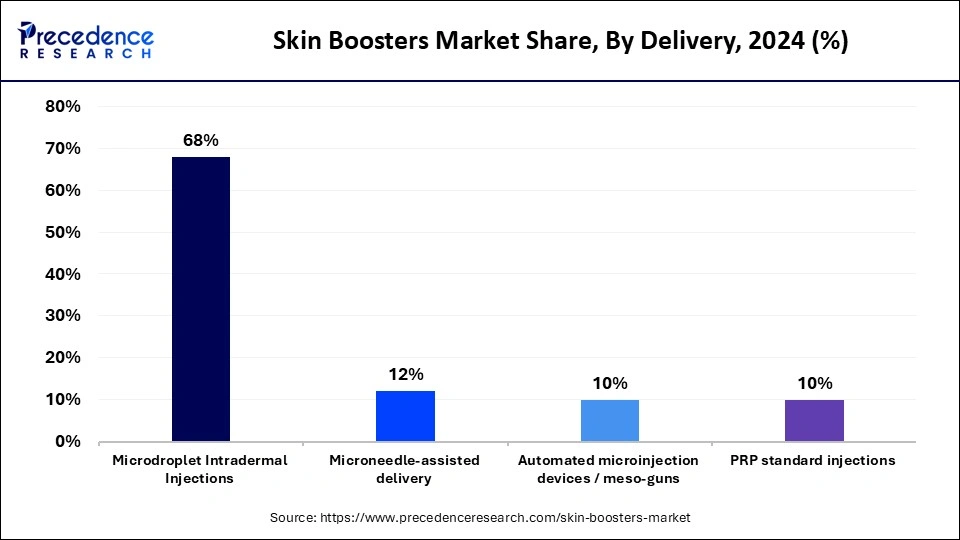
Automated microinjection devices, such as meso-guns, represent the fastest-growing delivery method for skin boosters. These devices utilize advanced technology to inject precise doses of product into the skin with high speed and accuracy, improving efficiency and patient comfort during treatments. Automated systems are gaining popularity in clinics and MedSpa's as they reduce the risk of human error and enhance consistency in results. The increasing adoption of meso-guns is fuelled by their ability to streamline procedures, making them ideal for high-volume clinics and aesthetic chains. As the demand for faster, more efficient treatments rises, these devices are becoming more accessible and widely used in the market. The growing trend toward automation in aesthetic treatments is expected to continue, driving significant growth in this segment.
End User / Channel Insights
Why Dermatology and plastic surgery clinics are Dominating the Market?
Dermatology and plastic surgery clinics remain the dominant end users for skin boosters, accounting for approximately 60% of the market share. These specialized medical settings are the primary locations where consumers seek professional-grade skin treatments, particularly for rejuvenation and anti-aging purposes. Clinics offer a high level of expertise and personalized care, ensuring safe and effective treatments for patients. The trust associated with medical professionals, coupled with the ability to address complex skin concerns, contributes to the dominance of this channel. Dermatologists and plastic surgeons are increasingly incorporating skin boosters into their service offerings, further reinforcing their role in the market. As demand for non-invasive aesthetic procedures continues to rise, clinics will likely remain the go-to option for premium treatments.
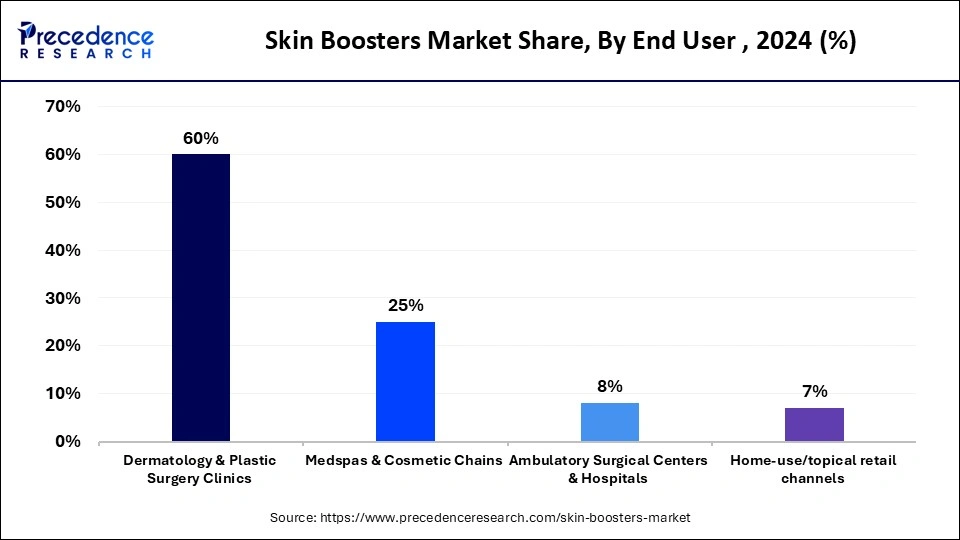
Medspas and cosmetic chains are the fastest-growing end user segment in the skin boosters market, with a projected 25% market share by 2024. The expansion of medspa franchises and the increasing presence of non-physician providers are driving higher procedure volumes and making skin boosters more accessible to a broader consumer base. These establishments often offer a wide range of aesthetic services, including skin boosters, at more affordable prices than traditional clinics. The growing popularity of medspas, combined with their ability to offer high-quality, minimally invasive treatments in a relaxed environment, has made them a preferred choice for many patients. As the trend toward convenience and affordability continues, this segment is expected to experience rapid growth. The accessibility and ease of booking treatments at medspas and cosmetic chains are significant factors contributing to their market expansion.
Business Model / Revenue Stream Insights
Why are Procedure fees and clinic services is Dominating the Market?
The dominant revenue stream in the skin boosters market comes from procedure fees and clinic services, accounting for most of the market value. Clinics and aesthetic centers charge patients for the procedure itself, which typically includes consultation, treatment, and aftercare. These fees vary based on the complexity of the procedure, the expertise of the practitioner, and the region in which the service is provided. The high value of these services is driven by the premium nature of skin booster treatments, which are considered luxury, high-quality offerings. As demand for non-invasive skin treatments grows, these revenue streams are expected to continue driving market value. Clinics and practitioners can also capitalize on repeat customers, as skin boosters generally require touch-up treatments every few months.
Bundled combo-protocols, which combine injectables, devices, and topicals in a single treatment package, are growing in popularity as an alternative revenue stream. These bundled offerings provide patients with a more comprehensive aesthetic solution, often at a discounted rate compared to purchasing each treatment separately. This business model encourages higher-ticket procedures and increases overall treatment volume.
Clinics and aesthetic centers benefit from offering multiple treatments in one session, enhancing the patient experience and increasing their revenue per visit. As consumers seek more value-driven options, these bundled protocols are becoming an attractive choice. The trend toward combination therapies is expected to continue as practitioners seek to differentiate themselves in an increasingly competitive market.
Regional Insights
U.S. Skin Boosters Market Size and Growth 2025 to 2034
The U.S. skin boosters market size is exhibited at USD 536.63 million in 2025 and is projected to be worth around USD 1,652.36 million by 2034, growing at a CAGR of 13.26% from 2025 to 2034.
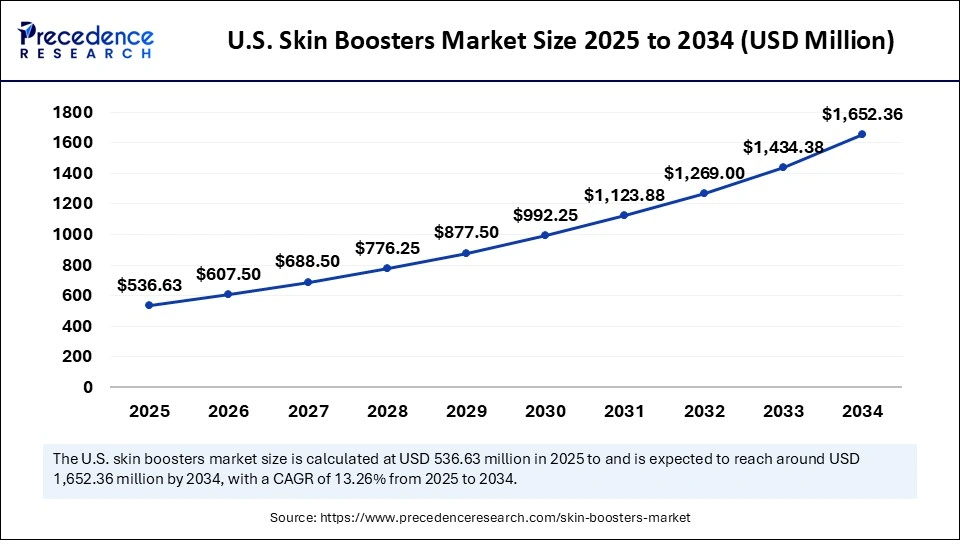
Why North America is Catching the Ladder of Growth in The Skin Boosters Market?
North America dominated the market, holding largest market share by 45% in the year 2024, driven by a high demand for advanced aesthetic treatments and a well-established culture of skincare and beauty. The United States remains the largest contributor to market growth due to its robust healthcare infrastructure, high disposable income, and strong consumer interest in both preventative and corrective cosmetic procedures. Additionally, the region benefits from a growing number of medical spas, dermatology clinics, and professional aesthetic providers who are increasingly offering skin boosters as part of their service portfolio.
The adoption of innovative technologies, along with the rising popularity of minimally invasive treatments, further supports market growth. Regulatory bodies, such as the FDA, have also played a significant role in ensuring the safety and effectiveness of skin booster products, fostering consumer confidence. As a result, North America continues to dominate the global market, with sustained growth driven by both demand and innovation.
How is Asia Pacific Accelerating the Growth?
Asia-Pacific is emerging as the fastest-growing market for skin boosters, driven by increasing beauty consciousness, rising disposable income, and the growing acceptance of non-invasive cosmetic procedures. Countries like South Korea, Japan, and China are at the forefront of this growth, where aesthetic treatments are widely embraced not only for their cosmetic benefits but also for their ability to maintain youthful skin. The rise in middle-class affluence across emerging markets, particularly in Southeast Asia and India, is contributing to the widespread adoption of skin boosters.
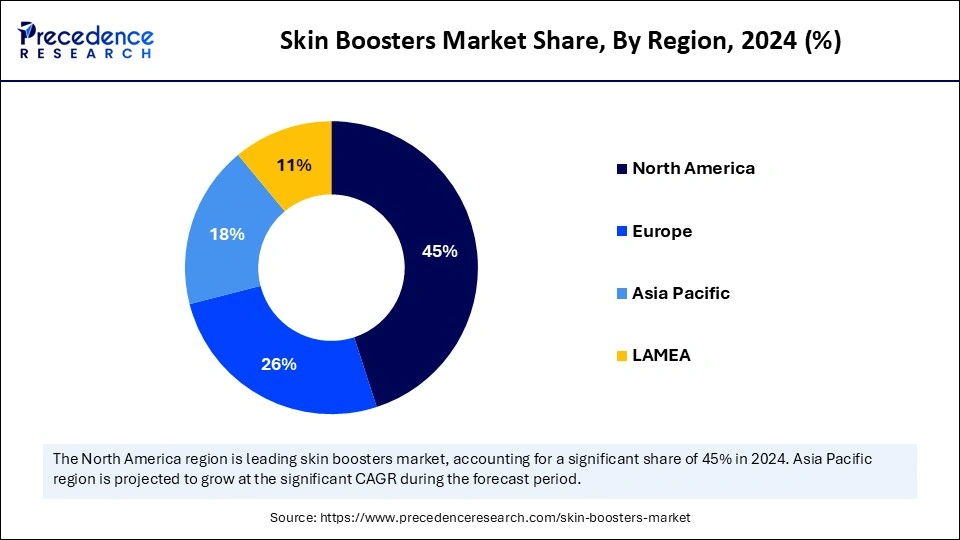
Additionally, advancements in medical technology and a surge in medical tourism are making high-quality aesthetic treatments more accessible. With the support of local governments and increasing international collaborations, the Asia-Pacific is expected to continue to experience rapid expansion in the skin booster market. Furthermore, the region's social media-driven beauty trends are significantly influencing consumer preferences, encouraging younger demographics to explore non-invasive cosmetic options. This combination of socio-economic factors is propelling Asia-Pacific as a key player in the growth of the global skin booster market.
Why is Europe Considered a Significantly Growing Market?
Europe is considered a significantly growing market for skin boosters. The European market is marked by high consumer awareness, strict quality regulations, and a well-developed healthcare infrastructure. It is mainly driven by an aging population seeking effective anti-aging solutions and a strong preference for non-surgical, minimally invasive aesthetic treatments. Leading players include major global pharmaceutical and aesthetic companies that dominate the market and invest heavily in research and development (R&D) to introduce innovative products and advanced application technologies.
Germany is a key player in the skin boosters market in Europe, known for its high standards of quality and safety in the aesthetic industry. The market benefits from a strong consumer focus on skin health and a preference for proven, high-efficacy products. Although specific data points are less prominent than those of the overall European market, Germany is home to major global companies like Merz Pharma, which actively innovate in the fields of aesthetics and dermatology.
What Potentiates the Growth of the Latin American Skin Boosters Market?
The market in Latin America is expanding, driven by rising consumer awareness of skin health, higher disposable incomes, and the growing influence of social media on beauty standards. Despite challenges such as high treatment costs and limited product penetration in certain areas, the market is positively shifting towards non-invasive aesthetic procedures, with Brazil at the forefront. The demand is particularly strong among millennials, fueled by a rise in aesthetic clinics and medical tourism, which is attracting investments from international aesthetic companies.
Brazil leads the market in Latin America due to its well-established cosmetics industry and a high volume of aesthetic procedures performed each year. The market's growth is driven by strong consumer interest in anti-aging and skin rejuvenation treatments, especially mesotherapy, a popular type of skin booster. National awareness campaigns and a focus on natural ingredients derived from the country's biodiversity are key trends. Both local and international companies are actively competing to meet the demand for effective and advanced skincare solutions.
How is the Opportunistic Rise of the Middle East and Africa in the Skin Boosters Market?
The Middle East and Africa are experiencing an opportunistic rise in the market, driven by a cultural emphasis on personal appearance, rising disposable incomes, and the expansion of medical tourism, especially in the Gulf countries. The region serves as a launching pad for international brands introducing innovative products, with high demand for premium, quality-specific solutions to address skin concerns in a hot climate. There is also increasing awareness through social media and growing interest in non-invasive procedures with minimal downtime, with Saudi Arabia projected to experience significant growth in the region.
In Saudi Arabia, the market is driven by the government's focus on healthcare modernization and ambitious smart city projects, such as NEOM. The market is characterized by a young, affluent population with a strong interest in aesthetics, driving significant demand for advanced, non-surgical facial rejuvenation solutions. International cosmetic companies are actively expanding their presence and introducing cutting-edge technologies to meet evolving consumer preferences and increasing discretionary spending.
Value Chain Analysis
- Research and Development and Ingredient Production
Focuses on developing formulations such as hyaluronic acid and on bulk production of raw materials.
Key Players: Allergan Aesthetics (AbbVie), Galderma, Merz Pharma. - Clinical Trials and Regulatory Approval
New formulations undergo testing to ensure safety and effectiveness and secure regulatory clearance.
Key Players: Aesthetic pharma firms and contract research organizations (CROs). - Manufacturing and Production
Involves large-scale, sterile manufacturing and packaging of final injectable products.
Key Players: Croma-Pharma, Hugel, LG Chem. - Distribution and Supply Chain Management
Products are distributed to healthcare facilities through complex supply chains, ensuring traceability.
Key Players: Specialized medical distributors and manufacturers' direct sales teams. - Service Delivery and Application
Treatments are administered by certified professionals in healthcare facilities.
Key Players: Dermatology clinics, medical spas, dermatologists, and plastic surgeons. - Patient Support, Marketing, and Post-Treatment Care
Focuses on consumer awareness, marketing, patient education, and long-term care management.
Key Players: In-house marketing teams, social media influencers, and technology providers for practice management.
Top Companies in the Skin Boosters Market and Their Offerings
- Galderma: Restylane Skinboosters (stabilized HA for deep hydration/texture) and Sculptra (PLLA collagen stimulator).
- Allergan Aesthetics: SKINVIVE™ by Juvéderm (HA microdroplet injectable for cheek smoothness and hydration).
- Merz Aesthetics: Belotero Revive (HA with glycerol for hydration, elasticity, and fine lines).
- Teoxane: TEOSYAL Redensity and RHA ranges (HA-based products compatible with natural skin movement).
- Sinclair Pharma: Perfectha dermal filler line and other innovative skin quality treatments.
Other Key Players
- RegenLab
- Sinclair / Vivo
- Anika
- AQTIS
- Sinclair
- BioAesthetics
- Suneva Medical
- MD Skin Solutions
- Dermapen / Eclipse
- Ilooda / Jeisys / Korean/Chinese OEM boosters
Recent Development
- In September 2025, The Lifebuoy bar is now formulated with advanced skin peptide boosters and Vitamin E, offering a gentle cleanse while helping to retain moisture. The body wash, enriched with skin peptide boosters and Vitamin B3, works to support and fortify the skin's natural barrier a key concept in modern skincare and daily health. Both formats are infused with skin peptide boosters, strategically designed to enhance skin resilience with each use, promoting long-term strength and protection.(Source: https://elle.in)
Segments Coverd in the Report
By Product Type
- Hyaluronic Acid (HA) Skin Boosters
- Cross-linked HA (low-viscosity optimized for dermal hydration)
- Non-crosslinked HA blends (shorter duration, lower-cost lines)
- Biostimulators / Low-dose Injectable Biomaterials
- PRP & Autologous Biologics
- Mesotherapy / Multi-vitamin & Amino-Acid Cocktails
- Topical “Booster” Serums & At-home Maintenance
- Delivery Devices & Microinjection Systems (needles, cannulae, automated injectors)
By Technology / Formulation
- Cross-linked HA optimized for intradermal use
- Low-molecular-weight HA blends
- Biostimulatory microparticles (PLLA, CaHA low-dose)
- Autologous biologic concentrates (PRP/PPP)
- Combination protocols
By Application / Indication
- Facial Skin Rejuvenation
- Fine lines & superficial texture
- Periorbital rejuvenation (targeted microinjections)
- Neck & Décolletage
- Hands & Dorsal Hand Rejuvenation
- Acne-Scarring & Skin Texture Improvement
- Scalp / Hair Quality Adjuncts (PRP combinations)
- Other specialty areas (perioral, post-procedure maintenance)
By Delivery / Procedure Type
- Microdroplet Intradermal Injections (needle or cannula)
- Microneedle-assisted delivery (combination with RF/needling)
- Automated microinjection devices / meso-guns
- PRP standard injections / topical infiltration
By End User / Channel
- Dermatology & Plastic Surgery Clinics
- Medspas & Cosmetic Chains
- Ambulatory Surgical Centers & Hospitals
- Home-use/topical retail channels
By Business Model / Revenue Stream
- Procedure fees & clinic services
- Product sales (vials/cartridges)
- Devices & consumables
- Bundled combo-protocols (injectable + device + topical)
By Region
- North America
- Asia Pacific
- Europe
- Latin America
- Middle East and Africa
For inquiries regarding discounts, bulk purchases, or customization requests, please contact us at sales@precedenceresearch.com
Frequently Asked Questions
Tags
Ask For Sample
No cookie-cutter, only authentic analysis – take the 1st step to become a Precedence Research client



 sales@precedenceresearch.com
sales@precedenceresearch.com
 +1 804-441-9344
+1 804-441-9344